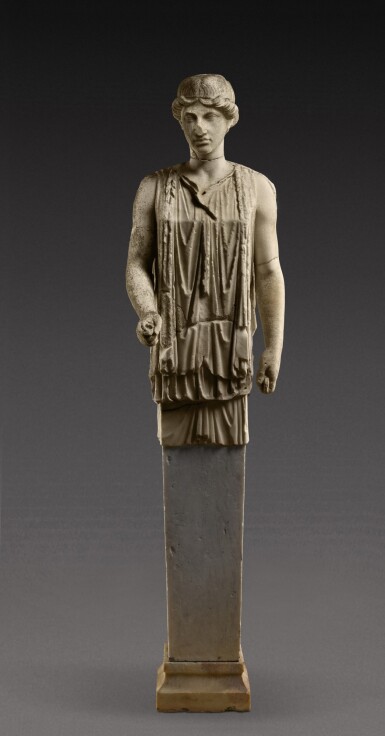
Property from a California Private Collection
A Roman Marble Herm of a Kore, circa 2nd Century A.D., with 18th Century Restorations
Auction Closed
December 7, 04:32 PM GMT
Estimate
100,000 - 150,000 GBP
Lot Details
Description
Property from a California Private Collection
A Roman Marble Herm of a Kore
circa 2nd Century A.D., with 18th Century Restorations
wearing a peplos with overfold, both arms lowered, her hair falling in twin strands over each shoulder and in a long plait over the upper back, the head (not belonging) with youthful features and centrally parted hair wound around a fillet ; lower part of herm pillar, right arm from mid upper arm with now missing key in right hand, left lower arm with now missing ewer in left hand, and some drapery folds restored; tip of nose formerly restored.
Height of ancient part 78 cm.; total height as restored 128 cm.
Gavin Hamilton (1723-1798), reportedly found by him in the Pantanello at Hadrian's Villa in Tivoli in 1769
William Petty Fitzmaurice, 1st Marquess of Lansdowne (1737-1805), Lansdowne House, London, received as a present from the above in 1775
by descent to Henry Petty Fitzmaurice (1872-1936), 6th Marquess of Lansdowne, Lansdowne House (Christie, Manson & Woods, London, Catalogue of the Celebrated Collection of Ancient Marbles, the Property of the Marquess Lansdowne, March 5th, 1930, p. 29, no. 41, illus.)
Whittall Collection, Grayswood, Haslemere, Surrey
in storage in London prior to 1955
William ("Billy") Haines (1900-1973) and Jimmie Shields (1905-1974), Brentwood, Los Angeles, on display in the garden
acquired together with the house and grounds by the present owner
Published
Comte de Clarac, Musée de sculpture antique et moderne, vol. 4, Paris, 1850, p. 365, no. 1933b, pl. 779
Salomon Reinach, Répertoire de la statuaire grecque et romaine, vol. 1, Paris, 1897, p. 460, no. 2
Adolf Michaelis, "Die Sammlung Lansdowne in London", Archäologischer Anzeiger, 1862, p. 338
Adolf Michaelis, "Die Privatsammlungen antiker Bildwerke in England", Archäologische Zeitung, vol. 32, 1875, p. 38, no. 49
Adolf Michaelis, Ancient Marbles in Great Britain, Cambridge, 1882, p. 462, no. 8
Arthur H. Smith, ed., A Catalogue of the Ancient Marbles at Lansdowne House, London, 1889, p. 38, no. 81
Hermann Winnefeld, Die Villa des Hadrian bei Tivoli (3. Ergh. JdI), Berlin, 1895, p. 159
Pierre Gusman, La villa impériale de Tibur (Villa Hadriana), Paris, 1904, p. 269, fig. 450
Georg Lippold, ed., Photographische Einzelaufnahmen antiker Sculpturen, series 17a, Munich, 1943, no. 4916, illus.
Cornelius C. Vermeule, "Notes on a New Edition of Michaelis: Ancient Marbles in Great Britain", American Journal of Archaeology, vol. 59, 1955, p. 140
Walter Trillmich, "Ein Kopffragment aus Verdolay bei Murcia", Madrider Mitteilungen, vol. 16, 1975, p. 223, no. 2
Cornelius C. Vermeule, Greek Sculpture and Roman Taste, Ann Arbor, 1977, fig. 16 Joachim Raeder, Die statuarische Ausstattung der Villa Hadriana bei Tivoli, Frankfurt a. M., 1983, p. 44f., no. I.21
Peter Schifando and Jean H. Mathison, Class Act: William Haines, Legendary Hollywood Decorator, New York, 2005, p. 179
Elizabeth Angelicoussis, Reconstructing the Lansdowne Collection of Classical Marbles, vol. 2, Munich, 2017, p. 415, no. 79, illus.
Sascha Kansteiner, "Review of Angelicoussis op. cit.," Gnomon, vol. 91, 2019, p. 70.
The female body of the present herm belongs to a series of which two other identical examples from the Esquiline are in the Musei Capitolini: H. Stuart Jones, The Sculptures of the Palazzo dei Conservatori, 1926, pp. 155 and 167, nos. 1 and 20, pl. 55 (http://arachne.uni-koeln.de/item/objekt/39792; http://arachne.uni-koeln.de/item/objekt/39793). The preserved head of one of them is that of an archaistic kore.
The male head attached to the body of the present herm is a replica of the so-called Hirth-Kassel type, which goes back to a Greek original of the mid 5th century BC. and could have represented Apollo. Notable replicas are in Kassel (https://datenbank.museum-kassel.de/26297), and in the Vatican (http://arachne.uni-koeln.de/item/objekt/21458). For the type see S. Kansteiner, Pseudoantike Skulptur II, 2017, p. 45f.
The present sculpture is mentioned in a letter by Gavin Hamilton to Lord Shelburne, August 9th, 1775 (I. Bignamini and C. Hornsby, Digging and Dealing in Eighteenth-Century Rome. Letters, 2010, p. 71f., no. 127): "I have therefore thought of two termine which I found in Hadrian’s villa. One is a Bacchus the other an Isis. From the middle upwards is a human figure, and down[wards] a plain termine. The Isis is very Elegant. I shall venture to send them, with some other pieces of sculpture for your Lordship’s garden, and which I beg you will accept as a present." The herm of Bacchus was sold at Christie's, London, December 16th, 2020, no. 50.
The 1775 Hamilton letter is the only document mentioning a Villa Hadriana provenance for the present herm. The object doesn’t appear in Hamilton’s own account of his findings there (I. Bignamini and C. Hornsby, Digging and Dealing in Eighteenth-Century Rome, 2010, p. 160). Since the present herm belongs to a series of which two other identical examples were found on the Esquiline in Rome (see above: H. Stuart Jones, op. cit., pp. 155 and 167, nos. 1 and 20, pl. 55), it is possible that the Lansdowne herm was actually found on the Esquiline rather than at Hadrian's Villa.
You May Also Like










